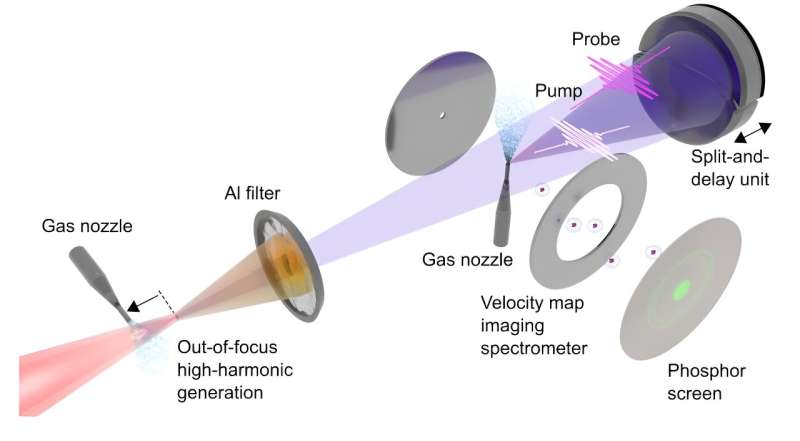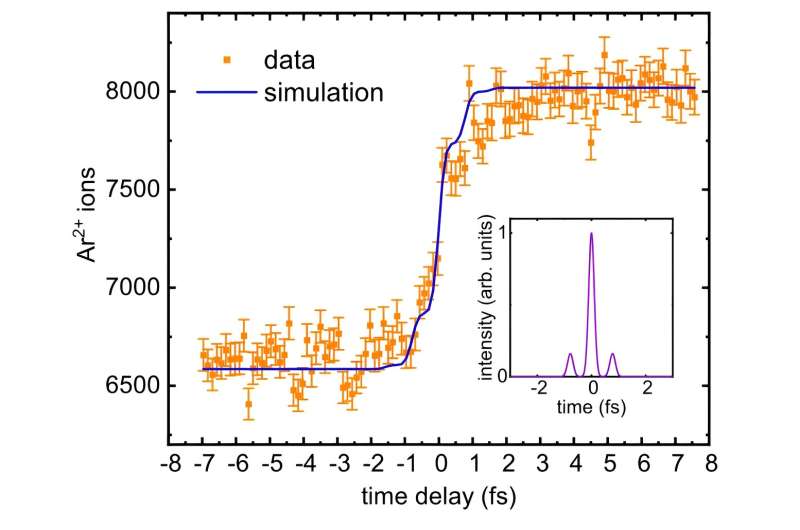This article has been reviewed according to Science X's editorial process and policies. Editors have highlighted the following attributes while ensuring the content's credibility:
fact-checked
peer-reviewed publication
proofread
A new chapter for all-attosecond spectroscopy: Researchers achieve 1 kilohertz repetition rate

A team of researchers from the Max Born Institute in Berlin has, for the first time, demonstrated attosecond-pump attosecond-probe spectroscopy (APAPS) at a repetition rate of 1 kilohertz. This became possible by the development of a compact, intense attosecond source using an out-of-focus generation geometry. The approach opens new avenues for the investigation of extremely fast electron dynamics in the attosecond regime.
The first generation of attosecond pulses (1 attosecond corresponds to 10-18 seconds) at the turn of this century has enabled unprecedented insights into the world of electrons. For their pioneering work, first leading to the demonstration of attosecond pulses in 2001, Anne L'Huillier, Pierre Agostini, and Ferenc Krausz were awarded the Nobel Prize in Physics in 2023.
Current attosecond techniques, however, come with an important drawback: To be able to record a movie in a pump-probe experiment, an attosecond pulse typically has to be combined with a femtosecond pulse (1 femtosecond corresponds to 10-15 seconds) whose optical cycles (a few femtoseconds long) is used as a clock with attosecond resolution. This constitutes a limitation for the investigation of electron dynamics on attosecond timescales.
Ever since the first demonstration of attosecond pulses, it has been the dream of many scientists to perform experiments in which a first attosecond pump pulse initiates electron dynamics in an atom, a molecule, or a solid-state sample, and where a second attosecond probe pulse interrogates the system at different time delays.
This goal turned out to be very challenging because it requires intense attosecond pulses. The underlying process of high-harmonic generation (HHG) is very inefficient, though. As a result, only very few proof-of-principle demonstrations of attosecond-pump attosecond-probe spectroscopy (APAPS) have been reported, which made use of large setups and specialized laser systems operating at low repetition rates (10–120 Hertz).

A team of researchers from the Max Born Institute (MBI) in Berlin has now demonstrated a different approach, allowing them to perform APAPS experiments using a much more compact setup. For this purpose, they used a turn-key driving laser at a kilohertz repetition rate. This resulted in a substantially more stable operation, which is a key requirement for the successful implementation of APAPS.
The scientists used infrared laser pulses for the generation of attosecond pulses in a gas jet. In contrast to how attosecond pulses are usually generated, however, they came up with the idea to place the gas jet not near the driving laser focus but at some distance away from it. As a result, attosecond pulses with a relatively high pulse energy and a small virtual source size were generated, which, after refocusing, enabled the researchers to obtain high-intensity attosecond pulses.
The researchers made use of this stable and intense attosecond source by performing an APAPS experiment, in which argon atoms were ionized by an attosecond pump pulse, resulting in the generation of singly-charged Ar+ ions. The formation of these ions was probed by an attosecond probe pulse, leading to further ionization and the formation of doubly-charged Ar2+ ions.
The results were an increase of the Ar2+ ion yield on a very fast timescale is observed. This shows that the involved pump and probe pulses indeed have attosecond pulse durations.
The modest infrared driving pulse energies used in this study open the way for performing APAPS experiments at even higher repetition rates up to the megahertz level. The required laser systems to drive these experiments are already available or under development. As a result, the novel concept may enable unprecedented insights into the world of electrons on extremely short timescales, which are not accessible by current attosecond techniques.
The findings are published in the journal Science Advances.
More information: Martin Kretschmar et al, Compact realization of all-attosecond pump-probe spectroscopy, Science Advances (2024). DOI: 10.1126/sciadv.adk9605
Journal information: Science Advances
Provided by Max Born Institute for Nonlinear Optics and Short Pulse Spectroscopy (MBI)




















